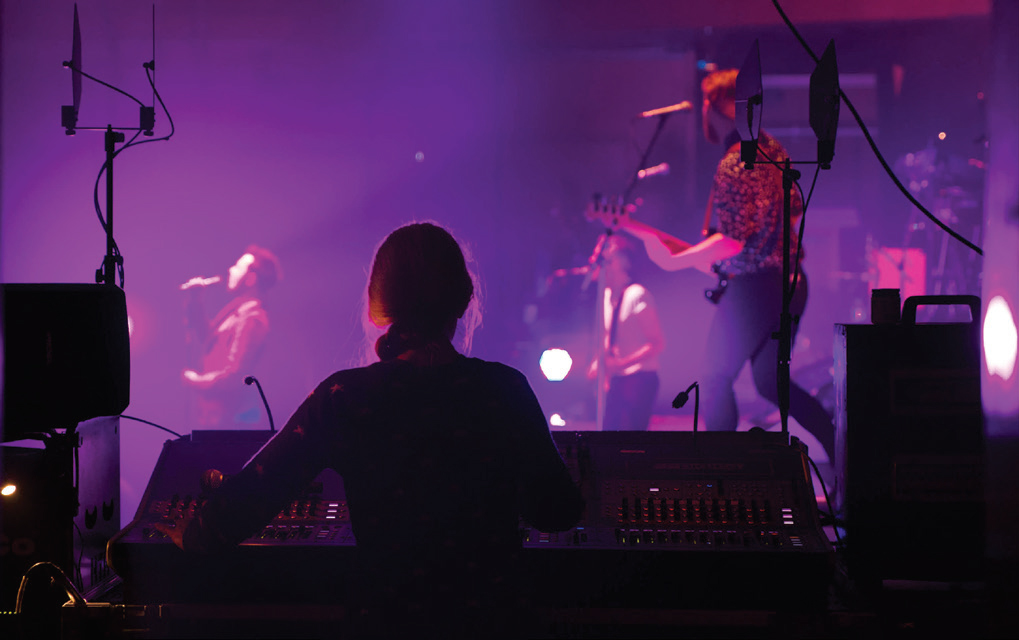Listen To/Download The Audio Version Of This Article:
The thrill of the performance, the privilege of working with music, the potential to not only travel the world but to get paid for it – there are many attractive aspects to being a live sound engineer. But what leads someone down the path of mixing monitors, and what are the benefits – and pitfalls – of that role.
Like most of us, it was a love of music which birthed my desire to be a sound engineer and being close to the energy of a live performance was – and still is – a joy. As a rookie I always enjoyed being at the stage end of things, and as much as I enjoyed hanging a big PA and hearing a front of house engineer tune the system and build their mix, I was always slightly more intrigued by the monitor engineer’s job.
I liked how they would walk to and from the stage, EQ’ing wedges using their voice as a guide, like they were tasting a recipe – “hmm, not bad, needs a little more power in this and a pinch less of that.” Sometimes an engineer I respected would ask me to “drive,” which I loved because I could both hear the changes they were making and learn how they were doing it.
A Great Start
In my early years I had the great privilege of working with Fred Jackson, who had mixed monitors on world tours with huge acts like Bruce Springsteen and New Kids on the Block and who came to work at the same PA company where I was learning my craft. Fred mentored me, frequently getting me to “drive” for him during set up and having me listen to my own voice in the wedges and offer my opinion. He encouraged me to pull out equipment in warehouse downtime and familiarise myself with frequencies and the EQ process, and when he told me I had good ears, I was over the moon.
Soon afterwards I was entrusted with my first forays into mixing – there was a popular music TV show in the UK in the late 1990s/early 2000s called CD:UK, and every week we supplied the monitor equipment for the live acts. There were some big names on the show such as Janet Jackson, Xtina Aguilera, and Ricky Martin, and of course they would bring their own engineers.
My role for those acts would be to serve as a tech (what I like to call “monitor butler”). But there would also be artists who arrived with no engineer, and then I was in the hot seat. I got to mix for many acts, including Lauryn Hill and Nelly Furtado that way. Was I “their” engineer? No, of course not – it was one song.
But that was where I learned the importance of good preparation and first impressions – a calm, confident greeting was exceptionally important when I had only moments to establish a basic rapport and give them the sense that they were in good hands, and so could relax and give a great performance.
The Upsides
It’s that additional human relationship element that I find so satisfying about mixing monitors. Of course, it’s essential that an artist trusts their FOH engineer to represent them well to the audience but there’s a personal touch to monitors – I’m creating a bespoke mix for the people who are creating the sound, so it’s a very individual service. I try to create a familiar environment for them wherever in the world we find ourselves – their “audio home” where they can relax and feel at ease – and I enjoy that interpersonal, empathetic side of the job.

I also love feeling very connected to the performance – there’s an immediacy to being intimately involved with the foundation of the gig, and when I get familiar with a performer’s preferences over time, it makes the show flow easily for both of us. There are many more of our tour “family” around stage than out front, and I find being part of the action and banter really fun.
I didn’t know in those early TV days how much more a monitor engineer is involved with the rehearsal process than their FOH counterpart. I might be working with a band for several weeks in rehearsals, supporting them as they build the music, before FOH joins in. I love that process, especially with a disciplined band who understand the importance of working methodically and getting the foundations right.
The early stages of rehearsal in particular are a very busy time for monitor engineers, while we manage the musician’s mix requests to get them to a place where they can run through songs. Those requests start out with standard, obvious things, and gradually become more subtle and nuanced as we tweak things to get them just right for each player. I always feel for FOH engineers who have to deal with managers, significant others, record company folk, and audience “experts’ critiquing their work – at least the people I mix for are totally entitled to ask for whatever they want, because it’s their mix!
Juggling people’s demands and distributing your attention are a feature of being a monitor engineer, and they’re skills that you only really acquire with experience. Over time, I’ve come to enjoy that part of the job a great deal – I find the experience of being intensely “in flow,” totally immersed in the work of that specific moment, to be hugely satisfying, like being at the eye of the storm.
The Downsides
I don’t mind demanding, high-maintenance characters, so long as everyone keeps it polite and respectful. Folks are usually pleasant in my experience, but like most monitor engineers I’ve also had less-than-cordial customers, and there’s no denying that patience is a big requirement of the job.
People are never at their best when they feel frustrated or scared, as they might do if they’re making mistakes in rehearsals or dealing with stage fright. It’s true that if the artist is having a bad day, so is the monitor engineer! “You’ve changed something” – no, it’s exactly where we left it, but maybe they had a fight with their partner, are exhausted by promo, or have a hangover; and so in that sense, yes, now it’s different. But you can’t say that!
You learn to recognize when you’re just the first person in the firing line of a freak-out, and generally I’ll let that stuff go (or of course make the necessary amendments if I’ve messed up! I’m a firm believer in the trust-building value of owning your mistakes.) But if I know I’ve done what’s required, and someone is repeatedly out of order, I’ll stand up for myself by finding an appropriate time to have a private conversation. That’s an opportunity to ask what’s going on, state my boundaries around basic respect and decency, reiterate our common goal, and hopefully get back on track.

Every bit as tricky as disrespect is the client who either doesn’t know what they want or can’t articulate it: “It just doesn’t sound right.” It often comes down to lack of experience, especially in the era of TV show-created stars who haven’t honed their craft on the club circuit and have no background of performing with a live band.
It can come as a shock to them to discover the vast difference between singing to track in a TV studio and singing in a tiny rehearsal space with a drummer crashing away behind them. No matter what an engineer does, it’s never going to sound exactly like the record in that environment – we can’t change the laws of physics. Helping a new artist to make that transition is a delicate process requiring, once again, a lot of patience.
Standing in for another engineer can be a minefield. You might have their session file and everything can be identical, but if yours is not the face that the band have come to trust as their audio comfort blanket, you might be in for a bumpy ride through no fault of your own.
What I’ve Learned
When it’s a good fit between monitor engineer and performers, being side of stage is an absolute joy and there’s nowhere I’d rather be. But we’re all humans, and with some humans you’ll hit it off, some you’ll rub along with OK, and as in life, there will be a few you never quite click with. After a quarter century in the game, the rules I live by include:
• Pick your battles and be empathetic, patient and tolerant, but have boundaries and don’t stand for repeated, intentional rudeness.
• Ask questions and try to understand where the client is coming from – what’s their background, what are they used to, what do they need?
• Showing up consistently and always giving your best means that you have a clear conscience and are less likely to take someone else’s bad day personally.
• Understand that you won’t click with some artists, but do your best to build trust and rapport despite that – they are totally dependent on you when they walk out on that stage, and that’s a very privileged position to be in. Honor it appropriately, and mixing monitors offers the great satisfaction of a life spent in service to that universal spreader of joy: live music.















